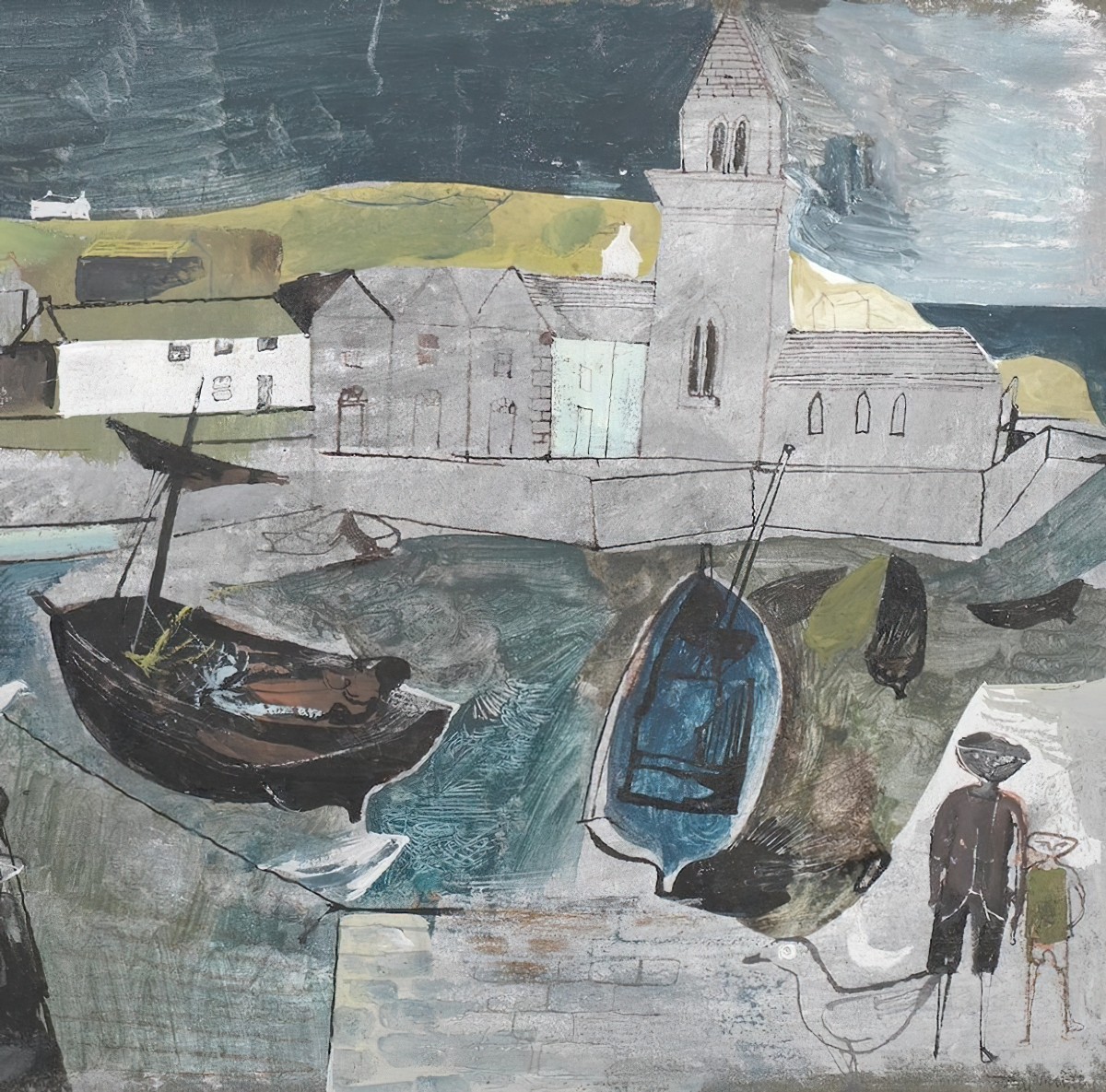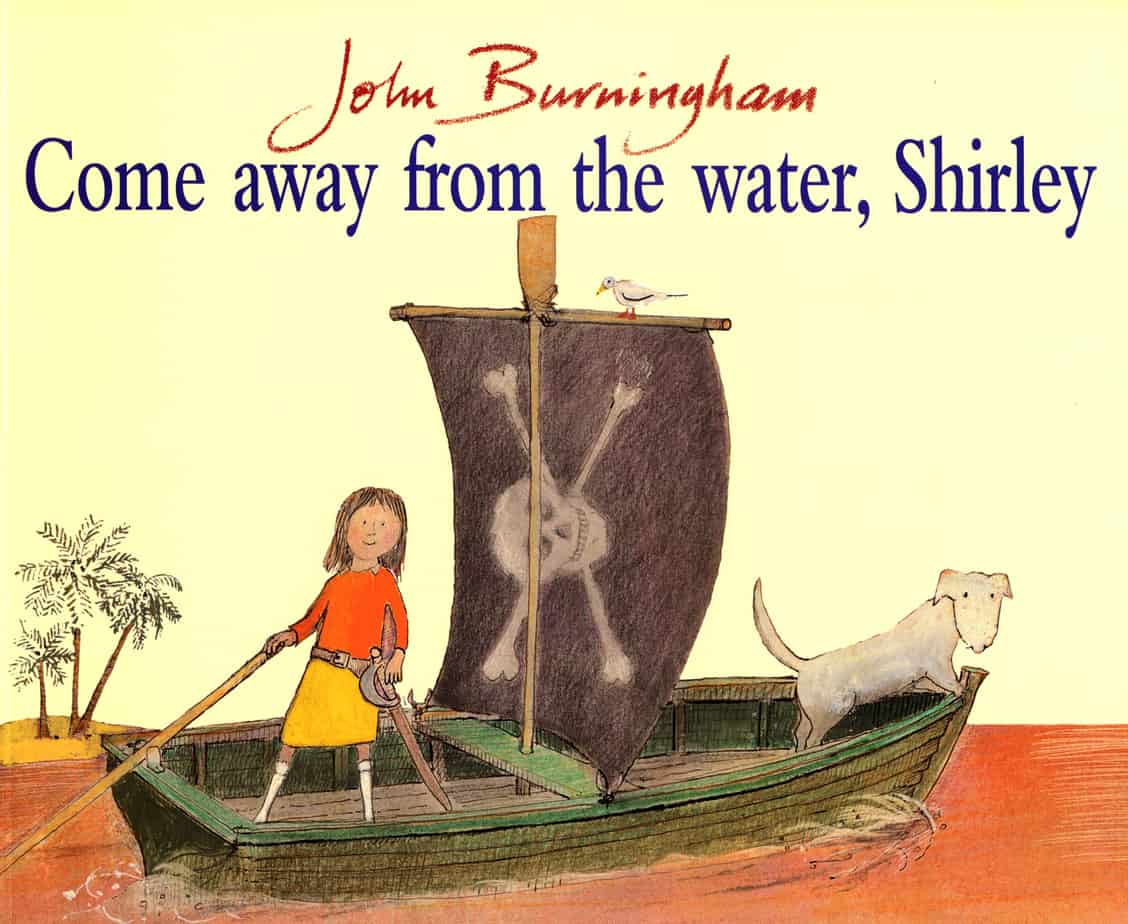Come Away From The Water, Shirley is a 1977 picture book written and illustrated by British storyteller, John Burningham. A number of adult readers talk about the “two different stories” going on in this book.
Whenever a story is illustrated, there are always two different stories being told, except in the most pedestrian of examples, in which the pictures exist only to clarify the words. I prefer to say instead that Come Away From The Water, Shirley is an example of a picture book with a very large ironic distance between the words and the pictures, bearing and mind that any given picture book can sit at any point on that sliding scale.
I can think of two other notable examples of picture books with a massive ironic gap, both of them also English: Rosie’s Walk by Pat Hutchins and Zoo by Anthony Browne. (All of Anthony Browne’s postmodern picture books work with a large ironic gap.)
Despite all being by English creators, and despite all three featuring a large ironic gap between pictures and text, they all use that gap quite differently.
First, let’s see how John Burningham used it. Then I’ll come back to the other two.


HOW THE ILLUSTRATIONS SHOW TWO DIFFERENT PERSPECTIVES
Burningham’s ‘Shirley’ books have … been extremely popular: Come Away From the Water, Shirley (1977) and Time to Get Out of the Bath, Shirley (1978). He demonstrates a sensitive and humorous understanding of the difference between the perspective of the adult and that of the child: the sensible and protective concerns of the parents are contrasted with Shirley’s desire to indulge her imagination and her sense of fun. The contrast is emphasised by the illustrations: Shirley’s parents are depicted in plain line drawings, while the facing pages abound with colour, offering exciting images from Shirley’s imagination.
British Council
CARNIVALESQUE STORY STRUCTURE OF SHIRLEY, COME AWAY FROM THE WATER
The text is composed entirely of dialogue, issued entirely from the mother, who is not in the mood to enjoy a trip to the seaside, but who is clearly in sergeant major mode. Meanwhile, the father is for all intents and purposes absent, there in body but not in spirit. He falls asleep in his deckchair, leaving all the parenting to Shirley’s mother.
An Every Child is at Home
For our purposes, ‘home’ in a picture book refers either to the house or to the caring adults who live in the house. I wouldn’t call these parents ‘caring’, exactly. They’re quite unpleasant. I’m interested to see the contemporary marketing copy which says this:
On a day trip to the seaside, Mom and Dad settle down in their deck chairs to snooze the day away, while for Shirley, it’s a chance to set sail for uncharted seas. “Come away from the water, Shirley,” caution her parents. But Shirley has already set out on an adventure, where she encounters danger, pirates, and buried treasure! John Burningham’s brilliant juxtaposition of both sides of the story will have children and parents laughing aloud.
MARKETING COPY
I’m reading this alone without a child audience, but is this really a ‘laugh aloud’ swashbuckling adventure? I find the story melancholic and lonely. The father is avoidant, and the mother won’t stop pecking and cajoling.
The Every Child wishes to have fun.
Although we say there are two stories happening across this picture book, there’s a third story also: The veridical reality that we don’t see. Shirley’s mother tells her to play with those children over there. But the only children shown to the reader are the children on Shirley’s imaginary pirate ship. The reader can deduce that there are other children playing on the beach, but we don’t see them on the beach. The three stories:
- The illustrations as shown to the reader
- The illustrations showing Shirley’s imagination
- The veridical storyworld, which must be different again to the illustrations Burningham chose to show the reader. Is there even a dinghy? He hasn’t shown us the children. So we really don’t know. The reader must make use of our own imagination to fill in this third storyworld.
Disappearance or backgrounding of the home authority figure
The verso sides of the spreads keep Shirley’s parents in the story all the way through, but I’m still calling this a take on the carnivalesque story structure because for the imaginative recto story, the parents are completely gone. Shirley’s not listening. She’s left the reader behind to hear whatever her mother has to say.
Appearance of an Ally in Fun

Across children’s literature, pirates are about the only criminals we happily accept as carnivalesque playmates in fun. Not sure why pirates get a pass when drug dealers don’t. (I do know.)
The Allies In Fun arrive on that pirate ship Shirley dreams up. Children hang off the sides of the ship, but soon Shirley is alone again.
Hierarchy is overturned. Fun ensues.
Shirley overturns the hierarchy of her parents first, by ignoring her mother entirely. Within her imaginative world she overturns hierarchy once again by defeating the pirates.
Fun builds!
The pirate makes Shirley walk the plank, but Shirley has stolen their treasure map, so she and the dog (imaginary or real?) make their way to the treasure island.
Peak Fun!
Shirley finds your archetypal picture book treasure chest and in the chest she finds a crown.
Surprise! (for the reader)
Shirley wears the crown, and now she’s Queen of her own World. This scene reminds me very much of Max’s crown after his trip across the seas to his imaginary island. The set up is also similar — the story starts off with a rift between Max and his mother. (He’s been rambunctious, and is sent to bed without dinner.)
Return to the Home state
The mother reveals they’ve been on a time limit this whole time. Children live on their own time, and are constantly feeling that their fun is curtailed by adults. The reader is never told why this small family must suddenly leave the beach, which is very much how it feels to be a young child — constantly shuttled from place to place on other people’s watch, never really knowing where it is you have to be, or why you have to be there right now. But we can assume they made it back to the Home state later that day.

COMPARE AND CONTRAST
In case you hadn’t already noticed, picture book awards committees love stories with a large ironic gap between words and illustration. These are the books that ask a lot of the reader, and stand up well to multiple reads.
Let’s return to Rosie’s Walk and Zoo (1992), each using ironic distance for a different effect.
COMICAL DRAMATIC IRONY
In Rosie’s Walk, a chicken goes about her business oblivious to the fact that a fox is following, hoping to eat her up. In Mr Magoo fashion, she haplessly makes it to safety, and the fox is mildly punished. The ironic distance in this iconic example is about humour, and the wonderful sensation children feel when they know something about the story the character does not. In the case of Rosie’s Walk, then, ironic distance between words and pictures exists to create what’s widely known as dramatic irony, with the audience in superior position.
IRONIC DISTANCE TO GUIDE THE READER
Now to Anthony Browne’s Zoo, the sobering carnivalesque. I feel Zoo is more similar to Come Away From The Water, Shirley in tone, though its position at the extreme end of the ‘ironic distance’ continuum puts it alongside Rosie’s Walk. In this picture book, a family has left the house for a day out at a designated ‘fun’ place (the zoo, the seaside). But instead of having fun, the parents are hurrying the younger, empathetic child character along. In Shirley’s case, she has been escorted to the natural landscape of the seaside, and is therefore able to retreat into her imagination in a fun kind of way. In Zoo, the young boy also retreats into his imagination, but to horrific effect: The framing visual narrative shows us he imagines himself as a caged-up gorilla. The entire zoo experience has been sobering, as he realises these animals are caged and, worse, city kids live in their own kind of cage. The ironic distance between the boy’s narration in Zoo and Browne’s surrealist illustrations gently guides readers towards making this connection for themselves. There’s a strong didactic message in Zoo, and this would have been too heavy-handed if conveyed in a more direct fashion.
IRONIC DISTANCE TO JUXTAPOSE THE VERIDCAL WORLD AGAINST THE CHILD’S IMAGINATIVE WORLD
In Come Away From The Water, Shirley, the ironic distance sets an imaginative example for children: No matter how hum-drum your real life, escaping into imagination is often an option. Let’s face it, imagination is the young child’s best chance of (simulated) independence.
FOR FURTHER INVESTIGATION
If you like the art style of John Burningham, you might like to check out 20th century artist John Minton.


